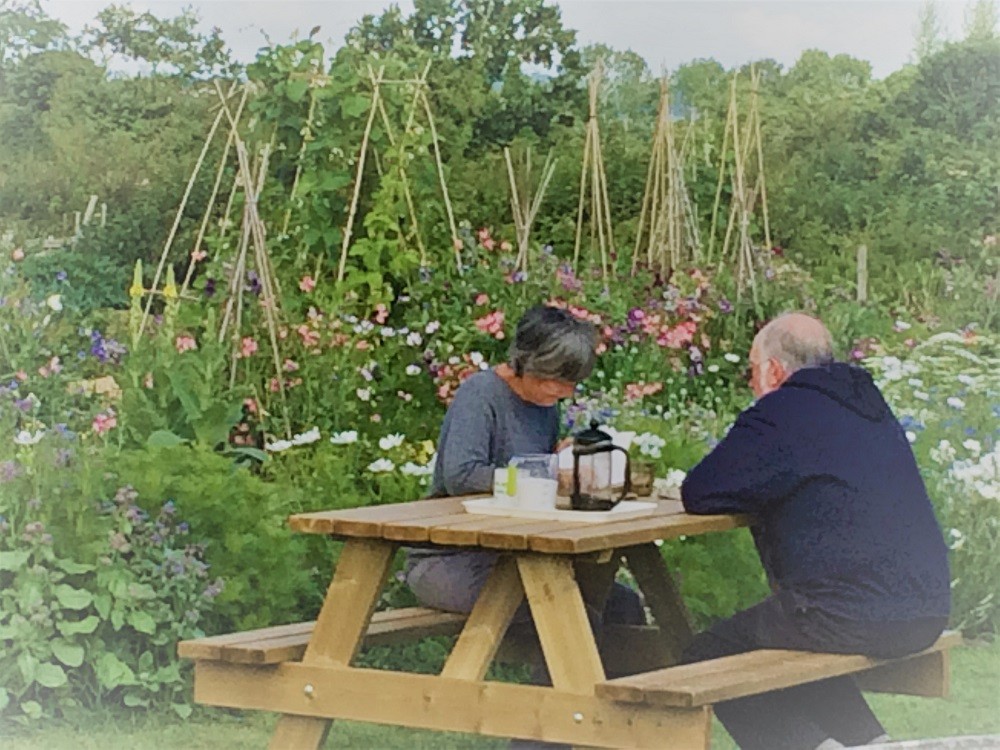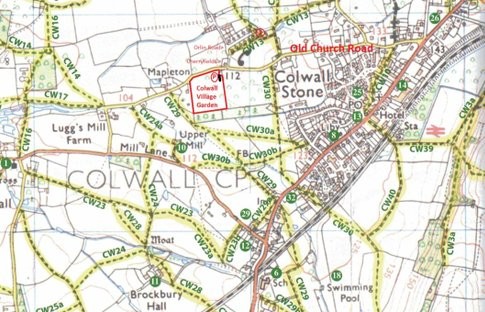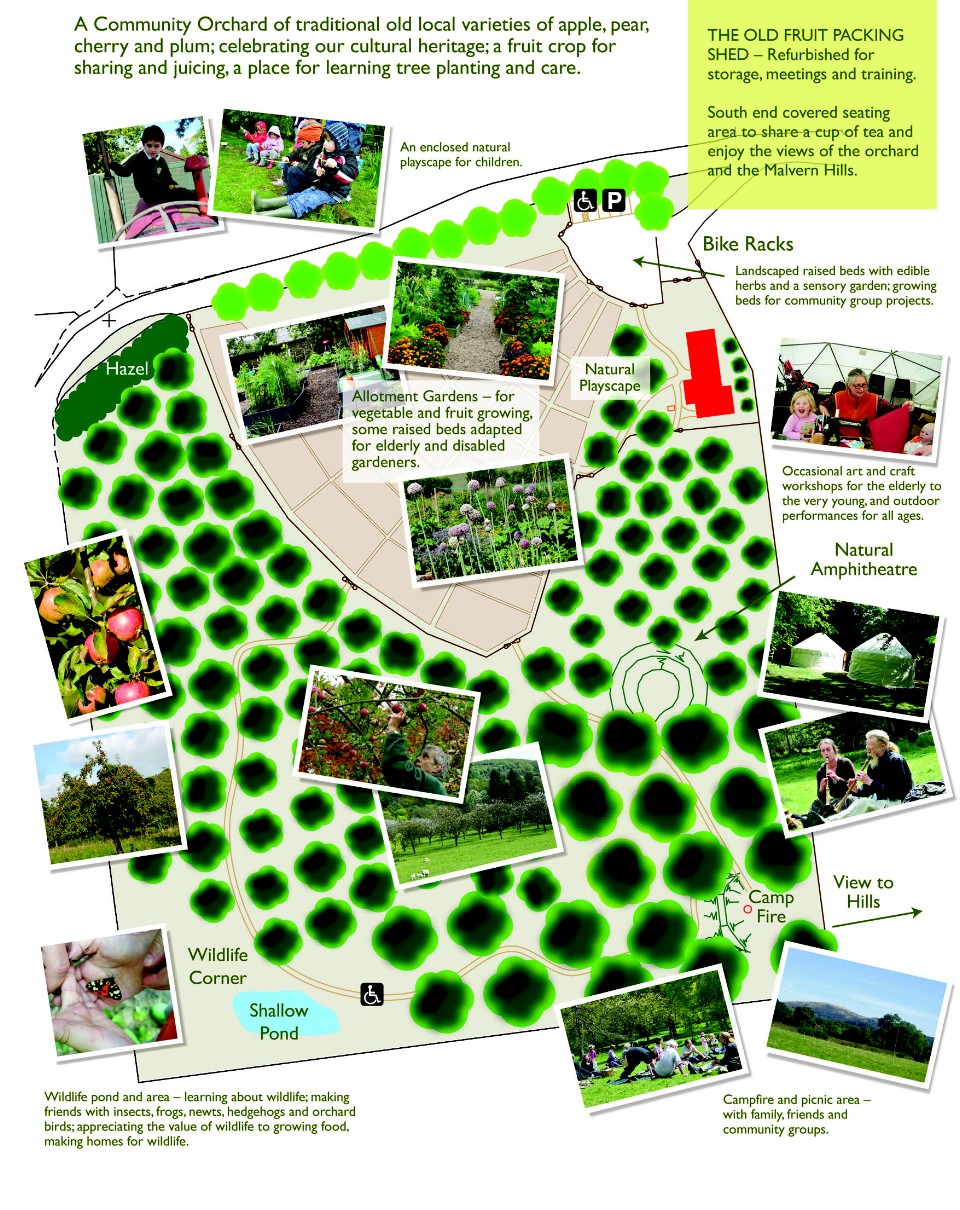Colwall Allotments

Allotments within Colwall are nothing new and there have, in the past, been allotments sited in various locations. Perhaps best known were the allotments situated close to the site of the former Ballard family Vinegar works in Stone Drive which, as they became vacant in the early 1900s were taken over as part of the Grovesend Fruit Farms and helped to supply fruit to the bottling and cannery plant. There were also allotments close to the Elms School, and I believe possibly at The Winnings and at Colwall Court.
The current Colwall Allotments are located in Old Church Road. Heading from Colwall Stone, via Stone Drive and then left down Old Church Road you pass the entrance to Orlin Road / Old Orchard Lane on your right and then on your left, almost immediately, there is a small track which leads to the Colwall Village Garden site.
The seven acre Colwall Village Garden site, also known as Gas Orchard, due to its proximity to the old Colwall Village Gasworks, was purchased in 2011 by Colwall Orchard Trust the local charity which exists to promote, celebrate and preserve traditional orchards in the Parish. Out of those seven acres around two acres are now divided into sixty allotment plots of varying shapes and sizes.

The current site was, according to the 1842 Tithe Map of Colwall Parish made up of parts of three separate fields then known as Mapleton, Lower Ground and Crooked Meadow. All three fields were categorised as being pasture on that map. The land was acquired in 1853 by Stephen Ballard and Thomas Brassey as part of the purchase of Upper and Lower Grovesend Farms, totalling some 76 acres in all and valued at £4,527 in 1852.
In 1873, the field boundaries of the three individual fields were straightened following the exchange of land with the Bright Estate and Lord Summers. Parts of three separate fields were then also combined into one. This was a deliberate policy of Stephen Ballard 1st to create a good-sized plot of land to enable the use of a stationary steam engine to cultivate the land, the steam engine being moved around and used at various locations on the Grovesend Estate. From an old Ballard family map of the Grovesend Farms it's understood that the site included a well which would have supplied the steam engine with water, and there would have been hard surfaced track access for coal to be brought across to the steam engine. Other old maps from the Ballard family estate show the location of underground spray mains which would have supplied various sprays such as limewash from a mixing station on land opposite The Homestead and that included a supply main serving the Colwall Village Garden site.
The site is believed to have been a plum orchard for the Grovesend Farms and would have supplied fruit for processing at the cannery in Stone Drive, or fresh for market, as part of a large-scale business for which the Ballard family were renowned in the first half of the twentieth century.
Situated on the seven acre site of the Colwall Village Garden is an old apple packing shed. In 2011 when the site was purchased by Colwall Orchard Trust this vernacular pole barn building was in a very poor state of repair and contained debris and rubbish from many years use as a lambing shed. The building is important as a traditional apple packing shed previously used for storing, sorting and packing fruit. The exact date of construction is unknown.
Gas Orchard was, in 2011, part of the estate of Park Farm Trust, owned by a branch of the Ballard family. During the 1970s it was rented by Geoffrey Knight, a descendent of Thomas Andrew Knight. Thomas Andrew Knight was the first Chairman of the Royal Horticultural Society, wrote a scientific treatise on varieties of apples and pears, invented the "methode champenoise" and revolutionised the British cider industry. Geoffrey Knight was also very interested in fruit and brought several Colwall varieties into commercial cultivation, including the "Captain Tom" apple and the "Golden Glow" apricot. Geoffrey Knight took on Gas Orchard after the Ballard's closed the Grovesend Fruit Farm and he set up a business as Geoffrey Knight Grovesend Sales. He rented several of the Apple Packing Sheds that used to be on Stone Drive, as well as Gas Orchard. There is some suggestion that the Apple Packing Shed may have been moved from Stone Drive to Gas Orchard at about this time, but there is currently no definite proof of this. He marketed fruit to wholesalers such as Glover and Burley in Birmingham, but also used to sell fresh fruit and vegetables from the Apple Packing Shed in a manner similar to the modern farmers' market business model. His chalk board, with prices still dimly visible on it, was still in the Shed when Colwall Orchard Trust bought it in 2011.
The building was completely refurbished and repaired in 2015/2016 and now contains storage and a classroom/meeting room known as "The Orchard Room" available for occasional rental at reasonable rates.
The Colwall Village Garden site was landscaped from 2011 onwards and now includes the allotment plots together with a community orchard planted with 250 traditional varieties of apple, pear, cherry, plum, mirabelle, quince, medlar, walnut and almond trees. The orchard is surrounded by a hedge of native species and in one corner, close to the adjoining plantation, there is a newly created pond – both of which are helping to create a wonderful location for wildlife.

The Colwall Allotment plots are available to rent and have to be tended on organic principles. Water and storage for tools are available on site.
The site is a wonderful location much appreciated by plot holders and casual visitors alike. You are very welcome to explore the Colwall Village Garden or simply to visit, sit down on the seats available, relax and enjoy the lovely view from this little piece of Eden within the village.
Sources
Colwall Village Society Newsletter: Colwall Allotments – So Where Are They Then? by Wendy Thompson